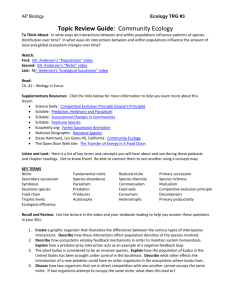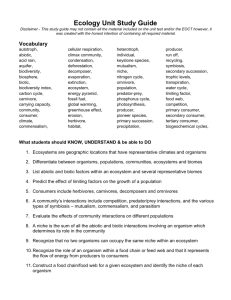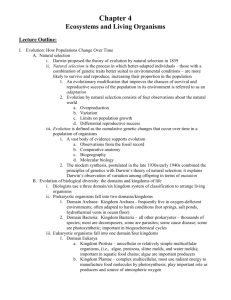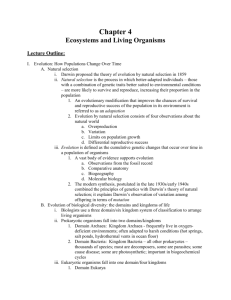File
advertisement
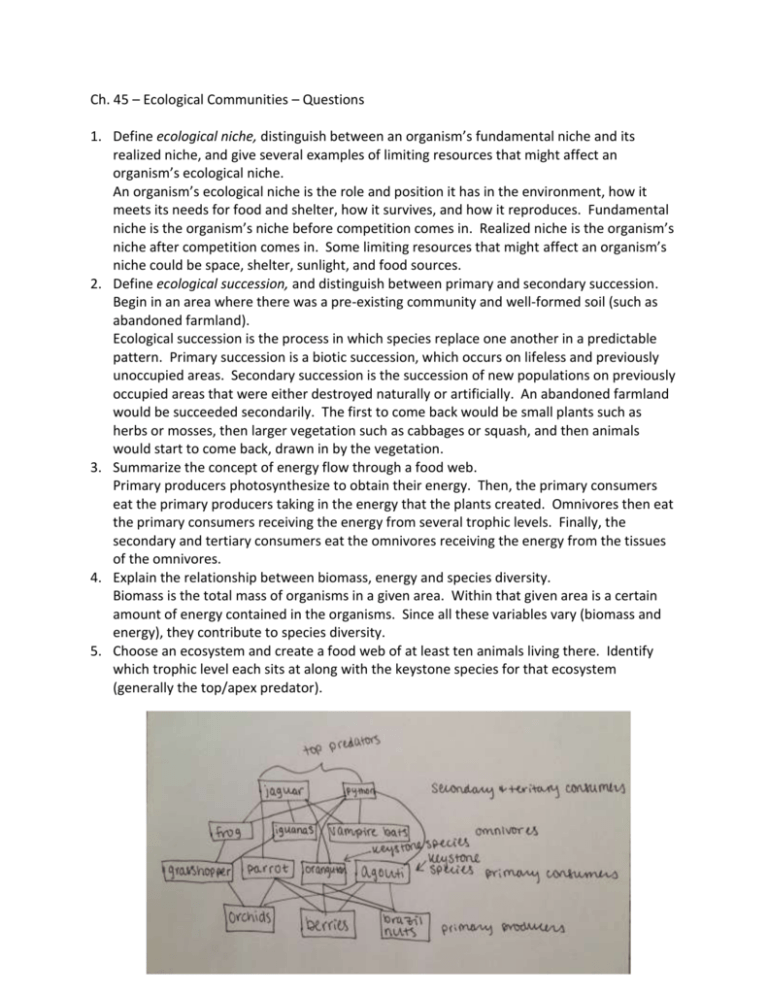
Ch. 45 – Ecological Communities – Questions 1. Define ecological niche, distinguish between an organism’s fundamental niche and its realized niche, and give several examples of limiting resources that might affect an organism’s ecological niche. An organism’s ecological niche is the role and position it has in the environment, how it meets its needs for food and shelter, how it survives, and how it reproduces. Fundamental niche is the organism’s niche before competition comes in. Realized niche is the organism’s niche after competition comes in. Some limiting resources that might affect an organism’s niche could be space, shelter, sunlight, and food sources. 2. Define ecological succession, and distinguish between primary and secondary succession. Begin in an area where there was a pre-existing community and well-formed soil (such as abandoned farmland). Ecological succession is the process in which species replace one another in a predictable pattern. Primary succession is a biotic succession, which occurs on lifeless and previously unoccupied areas. Secondary succession is the succession of new populations on previously occupied areas that were either destroyed naturally or artificially. An abandoned farmland would be succeeded secondarily. The first to come back would be small plants such as herbs or mosses, then larger vegetation such as cabbages or squash, and then animals would start to come back, drawn in by the vegetation. 3. Summarize the concept of energy flow through a food web. Primary producers photosynthesize to obtain their energy. Then, the primary consumers eat the primary producers taking in the energy that the plants created. Omnivores then eat the primary consumers receiving the energy from several trophic levels. Finally, the secondary and tertiary consumers eat the omnivores receiving the energy from the tissues of the omnivores. 4. Explain the relationship between biomass, energy and species diversity. Biomass is the total mass of organisms in a given area. Within that given area is a certain amount of energy contained in the organisms. Since all these variables vary (biomass and energy), they contribute to species diversity. 5. Choose an ecosystem and create a food web of at least ten animals living there. Identify which trophic level each sits at along with the keystone species for that ecosystem (generally the top/apex predator). 6. Summarize the main determinants of species richness in a community, and relate species richness to community stability. Species richness is determined by the number of animals in a species, and it can also be affected by the latitude that the species is in. The more animals in a species, the more stable the community is. There are better chances of successful reproduction and more “protectors”. 7. Explain what a tropic cascade is and how the elimination of wolves from Yellowstone National Park caused a trophic cascade. A trophic cascade is when a top predator alters the behavior of their prey causing the next level down to be released from predation. When the wolves were eliminated from Yellowstone, their prey (elks) were released from predation. This caused the elk population to soar. The elk started to eat all the aspen and willow up, leaving none for the beavers. 8. Why are islands so interesting to study trophic interactions? Islands are good to study trophic interactions because of the small amount of species. A trophic interaction quickly affects an island, giving almost immediate results. 9. Distinguish between bottom-up and top-down processes in ecosystem regulation and explain how these concepts can be used to improve diversity in an ecosystem. A top-down process is when an entire ecosystem is dependent on the top predator. A bottom-up process is when the entire ecosystem is dependent on the primary producers. The top-down process can help create more diverse populations of plants and insects because of its focus on the top predator. Bottom-up processes can help bring plants back into the population because they are necessary for this ecosystem regulation.



